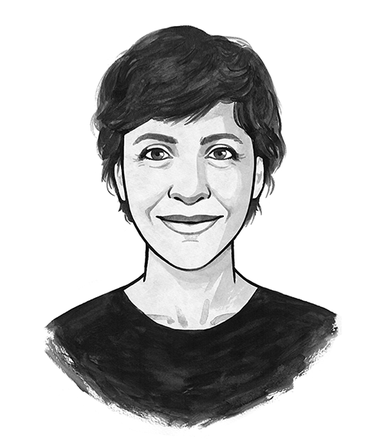Hi,
This week my son Lorenzo fell while bouncing around in the park. He was holding a tiny stick, which ended up poking him just above the eyelid. It was a miracle he didn’t scratch his cornea or poke his eye out.
But was it a miracle?
This is how I refer to it in my head every time I see the scabs on his face. I actually feel a chill down my spine and then I can’t help thinking about how vulnerable he is. I feel the fragility heightened by Lorenzo’s early-life wobbliness and by the fact that right now, in his first 1,000 days, my evolutionary purpose as a mother is to make sure he stays alive.
But why can’t I change the narrative in my head?
After all, the eyes represent just a tiny part of the body surface-wise. It is much more likely that Lorenzo would injure his legs or arms or other bits of his face rather than his eyes. Yet, it is hard to see the glass half-full, if you will, to look at the scab neutrally, to stop feeling the fragility of life.
“We’re not designed not to die.” This is how my colleague, Better Politics correspondent Nesrine Malik, put it during a meeting recently. She’s very right.
But death around the beginning of life is something that shakes us more than other deaths. And since reading (and writing) about the death of a five-year-old boy in Brazil, I’ve not been able to unsee other early deaths.
Why do children die?
Every year, some 5.3 million children die before reaching the age of five. Some 80% of those deaths take place in sub-Saharan Africa and south Asia. They happen in contexts where the healthcare system is under heavy strain and the causes of death are not investigated in detail.
But perspective is important, very important, here. It’s easy to call these early deaths tragic. To say that systems are broken, that the world is unfair. To shut down our brains and hide behind these paralysing, sweeping statements.
The truth is that in many cases, in most cases, these deaths are avoidable. But we need information to understand what exactly happens when a child dies. Because if those deaths are avoidable, and we know exactly how and why they happen, we can actually act. Just think of this: the rate of children who die before the age of five has fallen by more than half since 1990. It is positive progress, but it is only the beginning.
Last week I wrote about Miguel Otávio Santana da Silva, a five-year-old black boy who died in Recife, Brazil, while his mother was walking her employer’s dog. I referred to it as a death caused by a very ingrained structure: racism.
For those of you who didn’t read the piece, Miguel’s mother, Mirtes Santana, had had no choice but to bring Miguel in to work because there was no nursery available because of the coronavirus, and she could not miss out on work. When she went out to walk her employer’s dog, she left Miguel in the care of her employer, Sari Gaspar. But Miguel wanted to be with his mother. CCTV footage shows how Gaspar failed to get Miguel off the elevator of a 41-story condo building. Miguel pressed buttons at random until he reached the ninth floor, stepped onto a window and fell out of the building.
In my piece, I asked about all the steps that could have been taken to avoid Miguel’s death. If there had been a nursery programme for working mothers, he may not have gone to work with his mum. And, more importantly, I explored how structural racism affected the boy’s death. Santana is the maid of an affluent woman living in Recife, Brazil, a city founded on the profits of slavery.
Rebecca, a member of The Correspondent, rightly pointed out that “race may have nothing to do with the carelessness of a selfish white woman’s disregard for someone else’s child.” She is right.
But my point stands, and it is an important one. If we suppose that Miguel’s death was caused by the building’s lack of childproof infrastructure, we would put in childproof windows, for example. But the point is that until we call ingrained racism by its name, and face its deeper consequences, we won’t be able to stop replicating the same story.
Investigating the causes of mortality
I was pleased to see that an investigation into the underlying causes of death in some of the countries with the highest infant and childhood mortalities is happening. Preliminary results, published in the Lancet medical journal, have shown that infections cause the majority of deaths – revealing surprising data about bacteria that was not on investigators’ radars before.
This is possible thanks to non-invasive postmortem analyses of the causes behind children’s deaths put in practice by CHAMPS (Child Health and Mortality Prevention Surveillance).
The underlying idea is to better inform prevention efforts.
I know all of this is hard to read. That you may want to stop right now. But it is important. We need to call things by their name in order to know what to do about them.
Thanks for staying with me. Also, by the way, Lorenzo is fine. He just has a tiny scar that I am sure will go away!
Children through their own lens


To end on an optimistic note, I wanted to share this powerful photographic project on Instagram. Teenagers in the north of England are sharing their shots of life coming out of lockdown, from between the cracks of the fences keeping them in their homes, to the mental toll that being inside has had on them.
Artist and photographer Carolyn Mendelsohn is overseeing the project and has become a mentor to these teenagers to get their views out into the world.
You can read more about the project in this article, and support it here.
Until next week,
Irene
 Would you like this newsletter straight in your inbox?
Subscribe to my weekly newsletter where I talk about sexuality, reproductive rights and early childhood, discuss the best ideas from members and share updates on my journalism.
Would you like this newsletter straight in your inbox?
Subscribe to my weekly newsletter where I talk about sexuality, reproductive rights and early childhood, discuss the best ideas from members and share updates on my journalism.

